Of note, Army aircraft flight - following
procedures during this era were practically non - existent. This
was the beginning of the true Cold War but some procedures were
still in place from the U.S. Army Constabulary Period.
At fixed field locations, arriving or
departing pilots would sign in and out on a Constabulary Sign
Out Book which could be reconciled through the phones or radio
if necessary but even this simple system did not exist at field
locations. It was possible to fall “ through the cracks “ if no
one was carefully monitoring an aircraft departure and
subsequent anticipated arrival at another field site.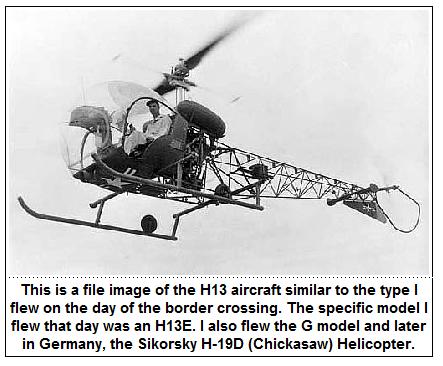
On the specific day in question. The
weather was not good but considered flyable. I picked up Herr
Kuehn and began the flight to Fulda. I elected to fly a compass
heading to the Fulda area and calculated the time of flight. I
planned to refuel at Fulda Army Airfield and then begin the
specific itinerary of Herr Keuhn’s inspection. In retrospect, I
should have been much better at the time honored traditions of
flying IFR ( I follow roads ) and was unaware that the magnetic
compass that I was using as the primary navigation aid had, if
fact, a 20-25 degree error.
I was following an east - northeast
compass heading and flying into a strong northwest head wind,
the combined affect of the compass error and the weather soon
had me much further south and east than my anticipated flight
plan. I would have caught the error had I been regularly
checking the roads and towns on my map with what we were
observing thru the bubble but, this was not the case. As heavy
snow showers further complicated the situation, I realized I was
disorientated and unsure of my location. As stated earlier, this
was well before all the navigational, radar and radio tracking
Army air traffic controls that would become so routine to
aviators a few years later.
One cannot be too proud to ask directions
and that is what we attempted to do. From the air, we spotted a
farmer and his ox cart and I set the helicopter down in an open
field to allow Herr Kuehn to find out where we were. I stayed
with the aircraft to study the maps, Herr Kuehn spoke with the
farmer. We naturally assumed we were still in West Germany;
sadly, this was not the case.
Captured
I guess if you’re going to be flying in
marginal weather with a bad compass and you become so lost as to
have to ask a German farmer for directions, you figure it
couldn’t get much worse. Well, it got worse.
At about the time that Herr Keuhn
determined we had crossed the border and landed in East Germany,
rumbling down the road towards us came a bus load of East German
border guards. At any other time of the day, the road would have
been just for farm use, but as luck had it, they were in the
middle of changing the guards so the bus was filled with troops
and we were truly in the wrong place at the wrong time. Looking
back at it, we were somewhere very close to the poorly marked
border in the rolling farm country to the southeast of Meiningen.
I looked up from the maps to see Herr
Keuhn being loaded into the bus and a group of guards
approaching the aircraft with weapons drawn. I shut the engine
down and was allowed to secure the blades with the tethers
before I too was loaded into the bus, a prisoner of the Cold
War. We were taken to their Headquarters.
Gone Missing - Search and Rescue
Operations
When I failed to show up at any of the
locations Herr Keuhn was anticipated at on 17 March, we were
reported missing and Army and Air Force units under the
direction of the 12th Air Force Rescue Service began a search.
Because of the bad weather and prevailing winds, they correctly
concluded that we should be in the near border area and by the
20th, concluded we had in fact gone d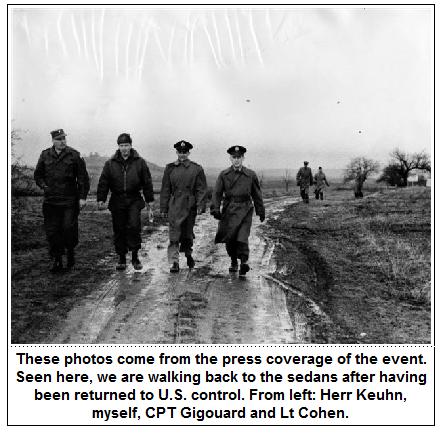 own in East Germany. While
U.S. Army and West German ground units continued the ground
search, U.S. Army Headquarters notified the Military Mission in
Potsdam, Berlin to contact their Soviet counterparts and request
assistance from their side in locating a crashed aircraft,
military pilot and West German civilian. We were now an
international incident.
own in East Germany. While
U.S. Army and West German ground units continued the ground
search, U.S. Army Headquarters notified the Military Mission in
Potsdam, Berlin to contact their Soviet counterparts and request
assistance from their side in locating a crashed aircraft,
military pilot and West German civilian. We were now an
international incident.
Russian Confinement
After a short time at the East German
Border Guard HQ we were turned over to members of the Russian
Army. We were taken to the HQ of an infantry unit in
Hildburghausen
and placed under armed guard on the second floor. Two
beds were brought into the room.
We assumed the room was intended as some
sort of information office, it was filled with Soviet
literature. The windows had bars but it was not a prison cell.
We had a good view of the Soviet military base, barracks area
and main gate. The immediate street below was used as an
assembly area for the Russian infantry platoons, traffic on the
street consisted of older lend - lease US built ¾ and 2 ½ ton
Dodge trucks. There was very little traffic through the gate, my
impression was that the town was off limits.
In spite of the run of bad luck, I recall
the humor of while watching Soviet troops standing in the rear
of a formation make snow balls and lob them over the heads of
the assembled troops at NCOs at the front. So much for their
discipline.
For the first few days there was no
attempt to interrogate either myself or Herr Keuhn. I came to
believe that no one in the unit spoke any English. On several
occasions, a Russian major escorted us on exercise walks on the
street in front of our building but nothing was said.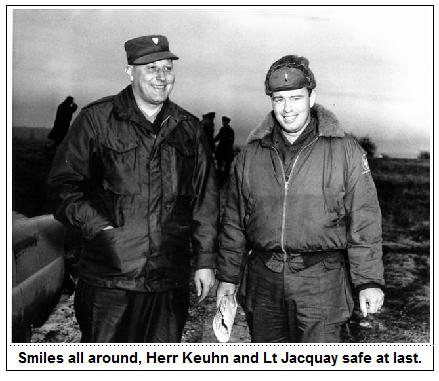
We were fed twice daily, on the same
schedule as the Soviet troops, the second meal was usually at
about 20.00 hrs. Our meals were the same as our guards, sort of
a thin meat broth with some vegetables and potatoes tossed in.
We were also given a bottle of cognac. We were also given a
checker board set, paper and pencils. Herr Keuhn and I passed
the time with checkers and playing the grid game of Battleship.
On the forth day of confinement, the
interrogators finally showed up and Herr Keuhn and I were
questioned separately. They seemed more interested in learning
personal information from me and appeared to accept at face
value, the story that I was simply ferrying the German national,
became lost in the bad weather and had by accident, landed in
East Germany. At no point did I feel threatened or intimidated.
The same seemed true for Herr Keuhn.
Meanwhile … Back in the West
While all of this was going on, events
were unfolding in West Germany. A German national who was
employed at the Coburg Officer’s Club located at the former
German barracks had been visiting family in the border area and
in fact observed from a distance, the landing and capture. He
reported this to his American employers and the story filtered
up the chain of command to the State Department. The Russians
still had not verified that we were being held or lodged the
expected complaint. In Berlin, the Soviets were formally
notified that the U.S. was aware that an Army pilot, West German
civilian and US helicopter were being held and that the
personnel were not injured at the time of capture.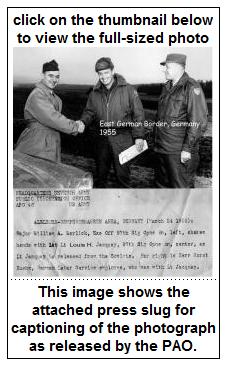
Return to US Control
On the morning of 24 March, we were given
hot water, soap and razors. We figured something was going to
happen but because the English speaking Soviets were not around,
it became a matter of some speculation. Our personal belongings
were returned and we were placed into a sedan. Under armed
escort, we departed the Kaserne and drove off in an unfamiliar
direction. After driving about 25 miles, I could see the bubble
canopy of the H13 in the distance. It was under Soviet guard and
we were not allowed to approach further.
After waiting for approximately 30
minutes, several olive drab sedans bearing large American flags
on each front finder came down the road. Inside were U.S. Army
personnel from the Military Mission in Potsdam and a pilot and
crew chief to look after the helicopter. The pilot was Captain
Phillip Neary of Manchester, MA and the Chief was Sergeant Jack
Henderson from Fort Wayne Indiana, my home town. They were
assigned to the 6th Infantry in Berlin and were to check out the
aircraft and then fly it to Straubing in the West. I was amazed
that we were allowed to take the aircraft back into U.S.
control.
In due course, Herr Keuhn and I were
driven to an ad hoc crossing point along the border in the area
between Alsleben and
Gompertshausen, about 22 miles northeast of
Bad Neustadt. At the border, First Lieutenant Theodore S. Cohen,
HQ 14th ACR in Fulda and Captain T. J. Gigouard, Hq 7th Army
signed documents that they had received us from Russian custody.
It was 9.45 AM on 24 March 1955.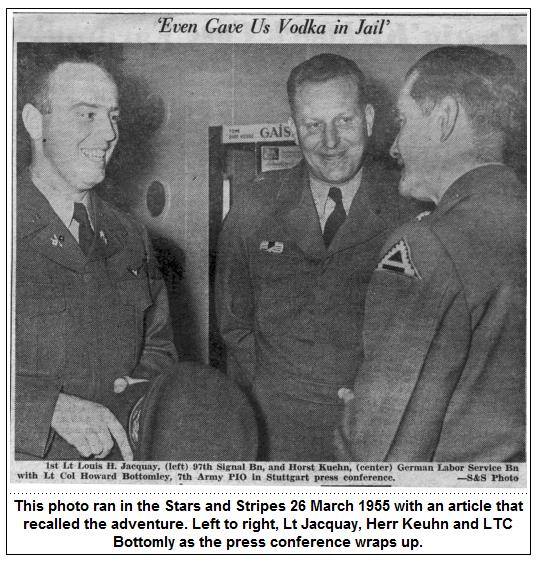
Herr Keuhn and I then were driven to Fulda
where a thorough physical examination occurred to confirm that
we were in good health and had not been injured while in Soviet
hands. 7th Army Aviation Section then flew us to Stuttgart -
Echterdingen airfield and then by car for a full day of
intelligence debriefing conducted by 7th Army personnel at
Ludwigsburg. At this point, they made it clear what we could and
could not say about the incident.
The Trip Home
The following day, Herr Keuhn and I parted
ways, each in our own separate Army sedan. I was being driven
through Stuttgart en route to Boeblingen when we suddenly heard
the wail of an MP siren. As we pulled to the side, an MP jeep
passed us leading a procession of two civilian cars. Much to my
surprise, as the cars shot by, I recognized my wife in the first
car and members of her family in the trail car. I asked my
driver to follow the group and we headed off towards the main
U.S. Army Hospital at Bad Cannstadt. When I finally caught up
with them, my wife was on the elevator on the way to the
Maternity Ward. That day, she delivered an eight pound 12 ounce
baby boy, my son Jeffery Robert.
Press Conference
On 26 March, 1955 a press conference was
held at the Graf Zeppelin Hotel in Stuttgart. Herr Keuhn and I
were present and were interviewed by LTC Howard Bottomley, 7th
Army Public Affairs Office. I was quoted as saying, “ I am
grateful for the aide and assistance given to my family by
American friends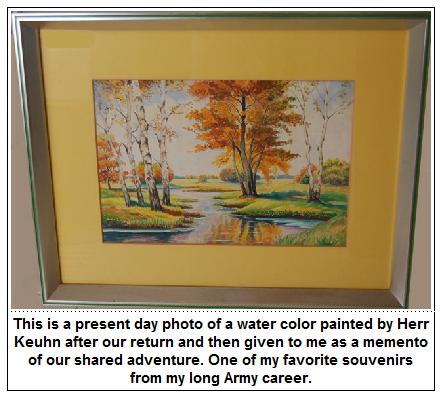
during my absence. “. I also thanked the
personnel involved in the search and rescue operation, my fellow
pilots who flew the border search missions and the men of the
14th ACR who conducted ground search operations in the border
area.
My Letter of Reprimand
The dust finally settled on this rather
exciting week in my life but not before it was punctuated by a
Letter of Reprimand signed by no one less than the Commander of
7th Army, Europe! Imagine, General Henry I. Hodes took the time
out of his undoubtedly very busy schedule to send me a letter! I
was reprimanded for exercising poor judgment in continuing to
fly the mission in such poor weather and for using an aircraft
not equipped for operations in such weather. The letter was
placed in my Field 201 file and removed upon my departure from
Germany at the end of my normal three year tour. I guess that
the Army needed aviators or the letter was not widely read, in
due course, I was promoted to Captain, integrated into the ranks
of the Regular Army and continued a long and exciting career in
Army aviation.